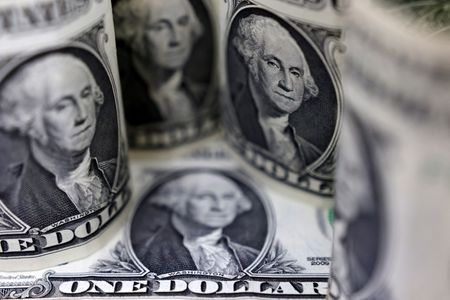By Karen Brettell
NEW YORK (Reuters) -The dollar dropped on Friday and was on track for its biggest daily loss against the yen since January 2023 after data showed that U.S. employers added fewer jobs in July than economists had expected, while last month’s jobs gains were revised sharply lower, leading traders to ramp up bets on how many times the Federal Reserve is likely to cut rates this year.
Employers added 73,000 jobs last month, below the 110,000 expected by economists polled by Reuters, while the unemployment rate edged higher to 4.2%, as anticipated, up from 4.1% in June. Job gains for June were revised down to 14,000, from the previously reported 147,000.
“It’s worse than anyone expected and the kicker is that downward revision for the prior month too,” said Helen Given, director of trading at Money USA in Washington.
The dollar index, which measures the greenback against a basket of currencies including the yen and the euro, was last down 1.23% on the day at 98.80.
The euro rose 1.37% to $1.1571 and was on track for its biggest daily gain since April. The single currency reached $1.1389 earlier on Friday, the lowest since June 10.
Against the Japanese yen, the dollar weakened 2.23% to 147.37. The greenback earlier reached 150.91, the highest since March 28.
The Fed has indicated it is in no rush to cut rates due to concern that President Donald Trump’s tariff policies will reignite inflation over the coming months.
Fed funds futures traders pared bets on how many times the U.S. central bank is likely to cut rates this year after Fed Chair Jerome Powell on Wednesday offered a hawkish outlook for monetary policy and declined to indicate that a cut in September was likely.
But they ramped up bets on cuts again on Friday after the jobs data. Traders are now pricing in 63 basis points of cuts by year-end, up from around 34 basis points on Thursday, with the first cut seen in September.
The dollar extended its drop on Friday after the Fed said Governor Adriana Kugler was resigning from the Federal Reserve effective Aug. 8.
Trump on Friday also ordered that the commissioner of the Labor Department’s Bureau of Labor Statistics Erika McEntarfer be fired after the weaker than expected jobs data and downward revisions.
Whether the Fed cuts in September may now depend on the next jobs report for August.
“(Powell) did say on Wednesday that we were looking at holding rates steadier for longer, but that we were going to get two sets of employment data before the next Fed meeting. So as this first set has been so decidedly negative… the labor market is clearly, clearly cooling, that’s going to raise the importance of that September figure as well,” said Given.
The August jobs data will be released on September 5, with the Fed due to meet on September 16-17.
A more dovish Fed would likely be negative for the U.S. currency, even after it has appeared to find its footing in recent weeks following a rough first half of the year.
“Our forecast for the dollar to strengthen in the second half of the year relies in large part on our view that the US economy will remain resilient and the FOMC keep policy on hold until 2026,” Jonas Goltermann, deputy chief markets economist at Capital Economics said in a note.
“Plainly, that now looks less probable; in a recession scenario the dollar is likely to weaken against lower yielding currencies such as the yen and the euro, even if it may rally against other, riskier currencies,” he said.
The dollar had gained earlier on Friday after Trump imposed new tariff rates on dozens of trade partners.
The Swiss franc was among the hardest hit as Switzerland now faces a 39% rate.
The Swissie fell against a range of currencies in response to Trump’s hefty duties and to his demand that pharma companies – key Swiss exporters – lower the prices at which they sell to U.S. consumers.
The dollar was last down 0.9% against the Swiss franc at 0.805, after earlier reaching 0.8171, the highest since June 23.
The Canadian dollar strengthened 0.43% versus the greenback to C$1.38 per dollar, after earlier easing to C$1.3879, the weakest since May 22. Canada was hit with a 35% tariff, instead of the threatened 25%.
The dollar had also gained against other currencies due to drivers other than tariffs. The yen was earlier headed for its largest weekly loss this year after the Bank of Japan signaled it was in no hurry to resume interest rate hikes, prompting Finance Minister Katsunobu Kato to say on Friday that officials were “alarmed” by currency moves.
In cryptocurrencies, bitcoin fell 2.65% to $113,432.
(Reporting by Karen Brettell; Additional reporting by Amanda Cooper; Editing by Mark Potter, Diane Craft and Daniel Wallis)










